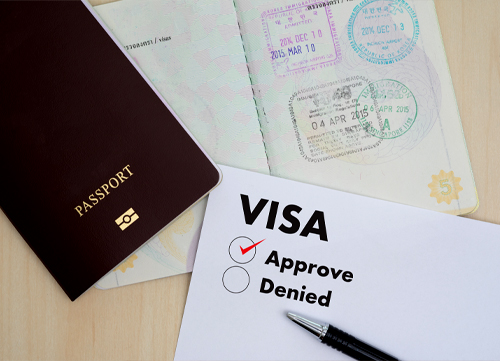PURSUE YOUR HIGHER EDUCATION IN ONE OF THE US UNIVERSITIES
The United States is the world’s leading student destination. It
offers unparalleled scope for students from all streams to study and excel in their chosen
fields. Coupled with an economy that requires new talent every year, it is the ideal destination
for students looking to study and make a life after graduation. With a US student visa, it is
possible to study in USA.
Fastcrop offers authoritative support students need to study in US
universities with a US student visa. Our understanding of the US education system and vast
experience with its student visa process make us your best bet to study in the US.
WHY STUDY IN THE USA?
The US universities are able to provide the best possible platform
to international students with a student visa. This is evident from their high rankings making
it worthwhile to study in USA. The country’s education system offers the most comprehensive
coursework to students with an equal emphasis on both practical and theoretical learning.
Affordable Education
Diversity and Flexibility
Outstanding support system for overseas students
Healthy and Safe Communities
Access to internships
Exciting Campus Lifestyle
COST OF STUDYING IN THE USA
The US Universities fall under two major categories: public-funded
and private institutions.
International students’ tuition expenses at state schools are
based on non-resident costs, which are still usually less expensive than those of private
universities. This is excluding the student visa fees. You will need approximately $10,000 to
$55,000 annually to cover your tuition fees when you study in USA.
UPCOMING INTAKES IN THE USA
US universities have 3 intakes.
Students have the option of choosing the term of their study from
three main flexible intakes, Spring (January), Fall (September) and Summer (May) when they study
in USA.
Intake 1: Fall Semester – It commences in
August/September and is the major intake.
Intake 2: Spring Semester – It commences in
January/February intake is also available.
Intake 3: Summer Semester – It commences in
May/June and is available for selected Courses.
You will have to choose an intake that best suits your requirements
and make your application accordingly. Remember the deadline to submit applications are usually
a few months before the starting date of the semester. You will also have to plan your US
student visa application to sync with your college application process.
Eligibility requirements for students in US universities:
Student Applicant
Students must be over 18 years of age.
International students can work on-campus up to 20 hours/week or less during the academic terms
and full-time during the academic break periods including the summertime.
Off-campus employment requires some form of written or documented authorization issued by either
the USCIS or OISS.
You must be currently in legal status and have been enrolled as a student on a F-1 student visa
in the US for a minimum of one academic year to be eligible for any form of off-campus
employment.
US Student Visa Requirements (F1 Visa)
You will generally need the following for your US Student Visa
application for US universities:
A valid passport with a validity date at least six months beyond your period of stay.
Recent passport size photograph.
Confirmation page of DS-160.
Form I -20.
Payment of application fees for SEVIS.
Application as a non-immigrant.
Your University will make you aware of additional requirements if any prior to your application.
STEPS TO APPLY
Step 1: Apply to a US school and get accepted
The first step is to apply to (and eventually be accepted to) a US
university. In the United States, most full-time undergraduate and graduate programs demand
applications by December or January of each year. Admission notices are usually sent out in
March and April.
Step 2: Get your school’s Form I-20 or
DS-2019
After being accepted to a school, you’ll receive one of two
forms: Form I-20 (Certificate of Eligibility for Nonimmigrant Student Status) for F-1 and M-1
students, and Form DS-2019 (Certificate of Eligibility for Exchange Visitor (J-1) Status for J-1
students.
Step 3: Pay the SEVIS I-901 fee
Go online and pay the I-901 SEVIS fee once you receive your I-20 or
DS-2019 form from your school. The price is 350 USD for F-1/M-1 students and 220 USD for J-1
students once again. (Those in short-term J-1 visa programs will only have to pay $35 USD.)
Step 4: Locate a US Embassy or Consulate in Your
Area
You must apply for an international student visa at the US embassy
or consulate nearest to you (ideally, in the city or region in which you live). The US
Department of State offers an online search for US embassies and consulates.
Please know that depending on which embassy you apply through, the
process for obtaining a student visa in the United States may fluctuate slightly.
Step 5: Fill out the DS-160 form online
After that, fill out the Online Non-immigrant Visa Application (Form
DS-160).
You will also select the US embassy where you will interview for
your visa on this application.
Step 6: Make an appointment for your visa interview
Contact your nearest US embassy or consulate (preferably, the one
you listed on your online application) to organize your visa interview after you’ve filed
Form DS-160.
Step 7: Make payment for your visa application fee.
After that, pay the application fee of 160 USD. This charge is the
same regardless of where you apply or where you are from.
It’s important to note that the exact date you pay this charge
will differ based on your embassy.
Step 8: Attend your visa interview
The interview is the final major step in the visa application
process. This interview will determine whether or not you are granted a student visa in the
United States.
Step 9: Pay the visa issuance fee
After being authorized for a student visa in the United States,
certain students are required to pay a visa issuance fee. Whether or not you must pay this fee
is determined by your nationality and the reciprocity agreement your country has with the United
States. You can use a chart on the US visas website to discover if you have to pay a visa
issuance fee.
Step 10: Get Your Visa
Your embassy will return your passport to you with your new visa in
it if you’ve completed all of the requirements above and gained approval for an
international student visa to the United States. It’s worth noting that certain embassies
will ask you to pick it up in person, while others will simply ship it back to you.
The length of time it takes for your visa to be processed varies by
embassy.
After You Graduate:
F1 Student Visa holders are eligible for up to 12 months of OPT (optional practical training) on
completion of graduation. That means you can work for a year after you finish your studies.
It is temporary employment permission allowing students the opportunity to gain practical
experience in their field of study.
After that, you’ll be required to apply for a work visa if you have to continue working in the
US. You can remain in the US up to 60 days after the completion of your course in US
universities even if you don’t have a job offer or haven’t applied for OPT
Student Dependent Visa
The student dependent visa is called the F2 Visa. The F2 visa is a non-immigrant dependent visa
where the immediate family members of the F1 student visa holders can come to the US. Dependents
include the spouse and unmarried children under the age of 21 of the individual who is studying
in US.
Eligibility conditions for the F2 visa
Must be the spouse of an F1 student visa holder.
Must be the dependent child (under 21 years and unmarried) of an F1 visa holder.
Applicant must have enough financial resources to support the family in the US
F2 visa requirements
Passport (both original and photocopies)
Visa application confirmation (DS-160)
A photograph conforming to U.S. visa rules
Birth certificate for dependent children
Marriage certificate for spouses
Visa fee payment receipt
Applicant’s I-20 form
Copy of F1 visa holder’s I-20 form
Applicant’s bank statements, tax records, and employment documents as proof of financial
stability
Benefits Of F2 Visa
Extended visa stays
If the primary F1 student visa holder extends his / her stay, then
the F2 visa dependents are also automatically eligible to apply for the extension. Filing Form
I-539 is enough to renew your F2 visa along with proof of your financial status.
Change of visa status
You can enter the U.S. on an F2 visa and subsequently request a
change of visa status. By enrolling in a US higher education program in US universities, you can
change your visa status to F1. If you find an appropriate job, you can request a change of visa
status.
Getting a Green Card
While you get a Green Card automatically when your primary F1 visa
holder receives one, you are also eligible to apply for one on your own. You can change your
visa status to a different one which allows for dual purpose (e.g., L1 visa) and then apply for
a Green Card. If you find employment, you become eligible for a Green Card.
Access to healthcare
F2 visa holders have access to medical services and hospitals in the
US. However, if you plan on a long stay or expect a medical situation, it makes sense to buy a
health insurance plan to cover the high costs of health care.
F2 VISA RESTRICTIONS
No permission to work
Not eligible for Social Security Number
Not allowed to pursue higher education
Cannot enter the U.S. before the F1 student visa holder
As you are not eligible to work, you can’t get a Social Security Number (SSN).
You can’t get employment in the United States on an F2 visa. But you’re allowed to do unpaid
voluntary work
You cannot do a Bachelor’s or Master’s degree program in US universites on the F2 visa. Yet you
are eligible for recreational and vocational training courses. Dependent children on an F2 visa
can complete primary, middle and high school education. If you are looking to pursue higher
studies, you must first apply for a visa status change.
You must either be accompanied by the primary F1 visa holder or fly later after the F1 holder
for first-time travel to the U.S. on an F2 visa. You can’t enter the United States before the F1
visa holder. This only applies when you are first entering the U.S. and not for subsequent
travel
M1 VISA – STUDENT VISA (VOCATIONAL COURSE)
M1 visa is a type of non-immigrant student visa issued by the USCIS
to foreign students looking to study in the United States, but not every student receives an M1
visa. This is primarily intended for those who want to pursue vocational training in the U.S.
Students can enter the US with an M1 visa and complete their
full-time vocational studies.
What can you do with an M1 visa
Using the M1 visa, as a student, you can obtain a driver’s license,
a bank account based in the U.S., access to health care services, and apply for work under
certain restrictions.
What you cannot do-.
Requirements for student visa application
You cannot apply for non-academic or vocational training courses in the US
You meet the minimum education qualification required for admission into the vocational course.
You were admitted by a U.S.-based educational school and got the Form I-20.
You have the appropriate level of proficiency in English
You’ve shown you’ve got enough funds to cover your expenses while you’re in the US
You have permanent residence in your country of origin
You have no intention of remaining in the US and will leave after your education is complete
The institution is convinced that the education you are receiving will benefit your country of
origin
Documents required
Passport valid for at least six months
DS-160 confirmation
Visa appointment letter
Recent photographs
Fee receipts
Educational certificates
Proof of financial stability
Apply for full-time employment outside the campus
Study the full-time course as part-time operation (which means
strict monitoring of attendance)
HOW Fastcrop CAN HELP YOU?
The US visa application process can be a daunting prospect. Fastcrop
will be by your side and assist you throughout the process. Fastcrop consultants are experienced
and well-versed with the intricacies of the US immigration process. Your dedicated consultant
will help you:
Identify and collect all your documents
Complete the visa documents checklist
Create your application package
Help to fill the various forms and applications accurately
Updates & follow up
Interview preparation
TOP UNIVERSITIES IN US
The QS World University Rankings include 150 universities
in the US.






